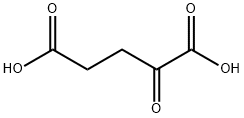Leader Biochemical Group |
|
| 2-Ketoglutaric acid Basic information |
| Product Name: | 2-Ketoglutaric acid |
| Synonyms: | 2-KETOGLUTARIC ACID;2-OXOGLUTARIC ACID;2-OXOPENTANEDIOIC ACID;A-KETOGLUTARIC ACID;Glutaric acid, 2-oxo-;Glutaric acid, alpha keto;-Ketoglutaricacid;α-Ketoglutaricacid |
| CAS: | 328-50-7 |
| MF: | C5H6O5 |
| MW: | 146.1 |
| EINECS: | 206-330-3 |
| Product Categories: | Nutrition;food additives;Pharmaceutical Intermediates;Aliphatics;Organic acids;pharm raw material;Amino Acids;Food Additives |
| Mol File: | 328-50-7.mol |
 | |
| 2-Ketoglutaric acid Chemical Properties |
| Melting point | 113-115 °C |
| Boiling point | 185.67°C (rough estimate) |
| density | 1.2821 (rough estimate) |
| FEMA | 3891 | 2-OXOPENTANEDIOIC ACID |
| refractive index | 1.3920 (estimate) |
| storage temp. | 2-8°C |
| solubility | H2O: soluble0.1g/mL, clear, colorless |
| pka | 2.47(at 25℃) |
| form | Crystalline Powder |
| color | White to slightly yellow |
| Odor | Odorless |
| Water Solubility | Soluble in water, methanol and dimethyl sulfoxide. |
| Merck | 14,5303 |
| JECFA Number | 634 |
| BRN | 1705689 |
| InChIKey | KPGXRSRHYNQIFN-UHFFFAOYSA-N |
| CAS DataBase Reference | 328-50-7(CAS DataBase Reference) |
| NIST Chemistry Reference | 2-Oxopentanedioic acid(328-50-7) |
| EPA Substance Registry System | Pentanedioic acid, 2-oxo- (328-50-7) |
| Safety Information |
| Hazard Codes | Xi,T |
| Risk Statements | 37/38-41-36/37/38-23/24/25 |
| Safety Statements | 26-39-45-36/37/39 |
| WGK Germany | 3 |
| TSCA | Yes |
| HS Code | 29183000 |
| MSDS Information |
| Provider | Language |
|---|---|
| alpha-Ketoglutaric acid | English |
| SigmaAldrich | English |
| ACROS | English |
| ALFA | English |
| 2-Ketoglutaric acid Usage And Synthesis |
| Description | 2-Ketoglutaric acid also known as α-Ketoglutaric acid (AKG) is a
chemical found in the body. It is a ketone derivative of the
organic compound glutaric acid. It is important for the proper
metabolism of all essential amino acids and the transfer of
cellular energy in the citric acid or Krebs cycle. In combination
with L-glutamate, AKG can reduce levels of ammonia formed in the
brain, muscles, and kidneys, as well as help balance the body’s
nitrogen chemistry and prevent nitrogen excess in body tissues and
fluids. α-Ketoglutaric acid is used for kidney disease; intestinal and stomach disorders, including bacterial infections; liver problems; cataracts; and recurring yeast infections. It is also used for improving the way kidney patients receiving hemodialysis treatments process protein. |
| References | [1] http://www.webmd.com [2] https://en.wikipedia.org/wiki/Alpha-Ketoglutaric_acid |
| Chemical Properties | Crystalline |
| Uses | A derivative of glutaric acid. |
| Definition | ChEBI: An oxo dicarboxylic acid that consists of glutaric acid bearing an oxo substituent at position 2. It is an intermediate metabolite in Krebs cycle. |
| Biotechnological Applications | a-Ketoglutaric acid is an intermediate of the tricarboxylic acid
cycle and the main compound of amino acid and protein metabolism.
This organic acid could be used as building-block chemical for the
chemical synthesis of heterocycles, dietary supplement, component
of infusion solutions, and wound healing compounds (Otto et al.
2013). Thiamine deficiency is a critical factor in the formation of a-ketoglutaric acid by Y. lipolytica. The yeast strain is unable to synthesize the pyrimidine structure of the thiamine molecule, or a medium with thiamine deficiency required for production of a-ketoglutaric acid. The a-ketoglutaric acid excretion was triggered after logarithmic growth phase when the yeast was grown on a medium containing hexadecane or other alkanes with low thiamine concentration (0.7 lg/L). The biosynthesis of the acid continued in the stationary phase. It was possible to increase the concentration of a-ketoglutaric acid to 108.7 g/L on petrolatum with a substrate-related yield of 120 % (Finogenova et al. 2005). The hyper-producing strain H355 produced highest amounts of a-ketoglutaric acid up to 195 g/L with a mixture of n-paraffins (C12–C18). Vegetable oils (olive, canola, sunflower, linseed, and rapeseed oil), ethanol, and glycerol were used as substrate for production of a-ketoglutaric acid by Y. lipolytica (Chernyavskaya et al. 1997, 2000; Il’chenko et al. 2001, 2002, 2003; Finogenova et al. 2002; Otto et al. 2013; Kamzolova and Morgunov 2013). The effects of different conditions on production a-ketoglutaric acid, including initial substrate concentration, nitrogen source, exogenous vitamins, and calcium carbonate are investigated in some studies. The influence of thiamine limitation and excess of carbon and nitrogen source as well as a low pH on the intensive aketoglutaric acid production are revealed in the previous work. Thiamine and calcium ion concentration had the greatest effect on this organic acid accumulation when glycerol was used as carbon source (Zhou et al. 2010). An increased amount of zinc and iron ions is required for the a-ketoglutaric acid production from ethanol (Kamzolova et al. 2012a). |
| Purification Methods | Crystallise the keto-acid repeatedly from Me2CO/*benzene, EtOAc or ethyl propionate. Dry it in vacuo.[Beilstein 3 IV 1813.] |
| 2-Ketoglutaric acid Preparation Products And Raw materials |